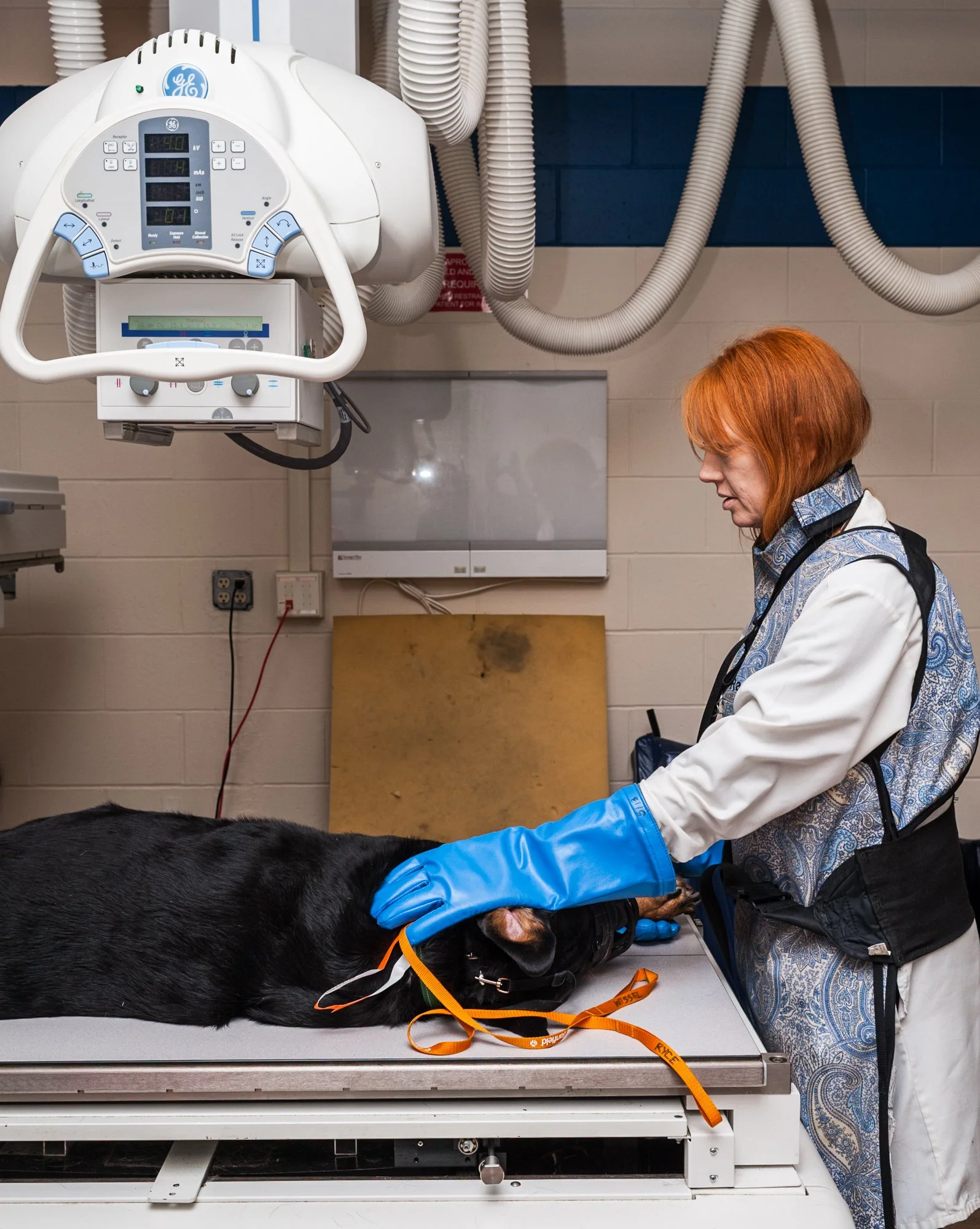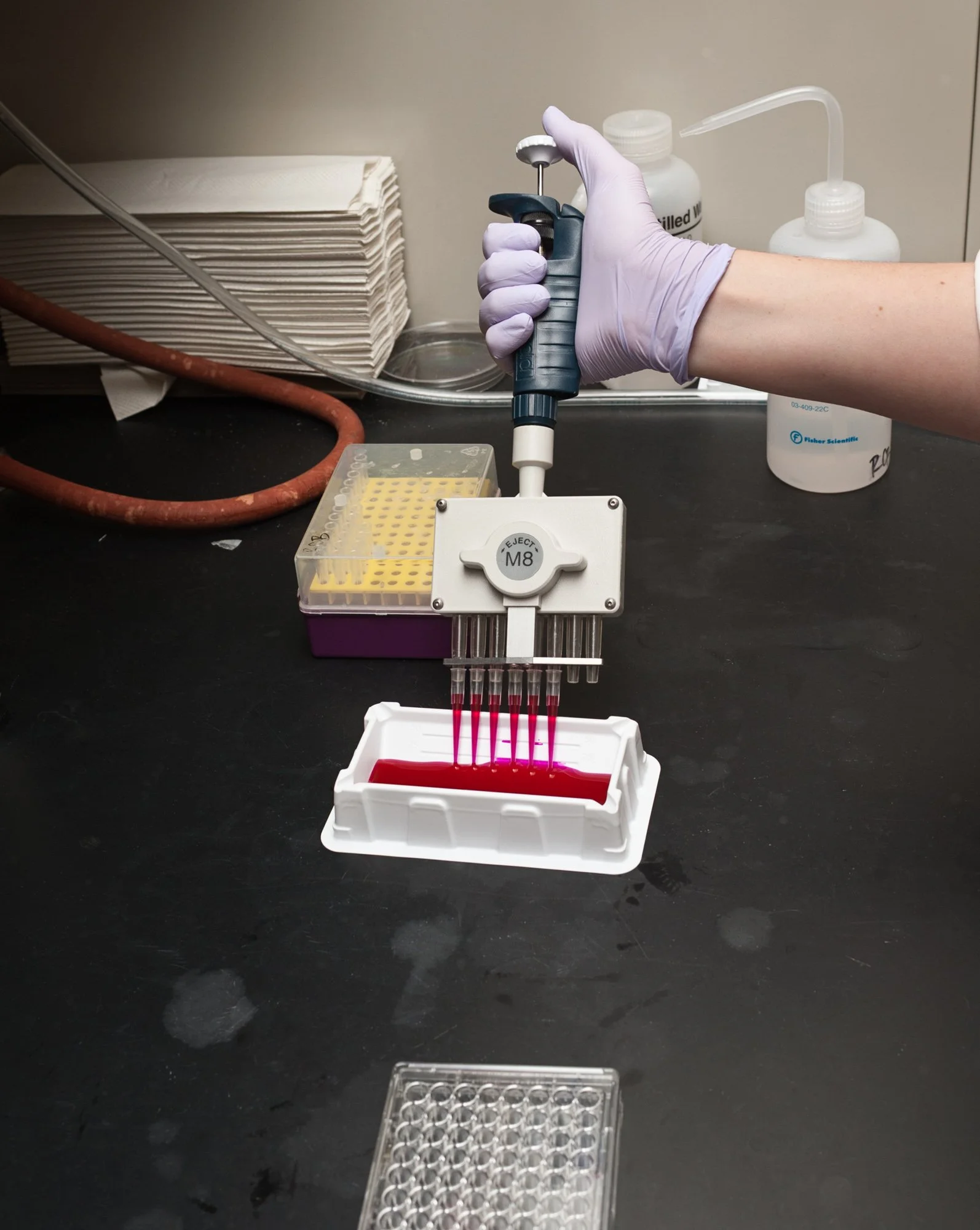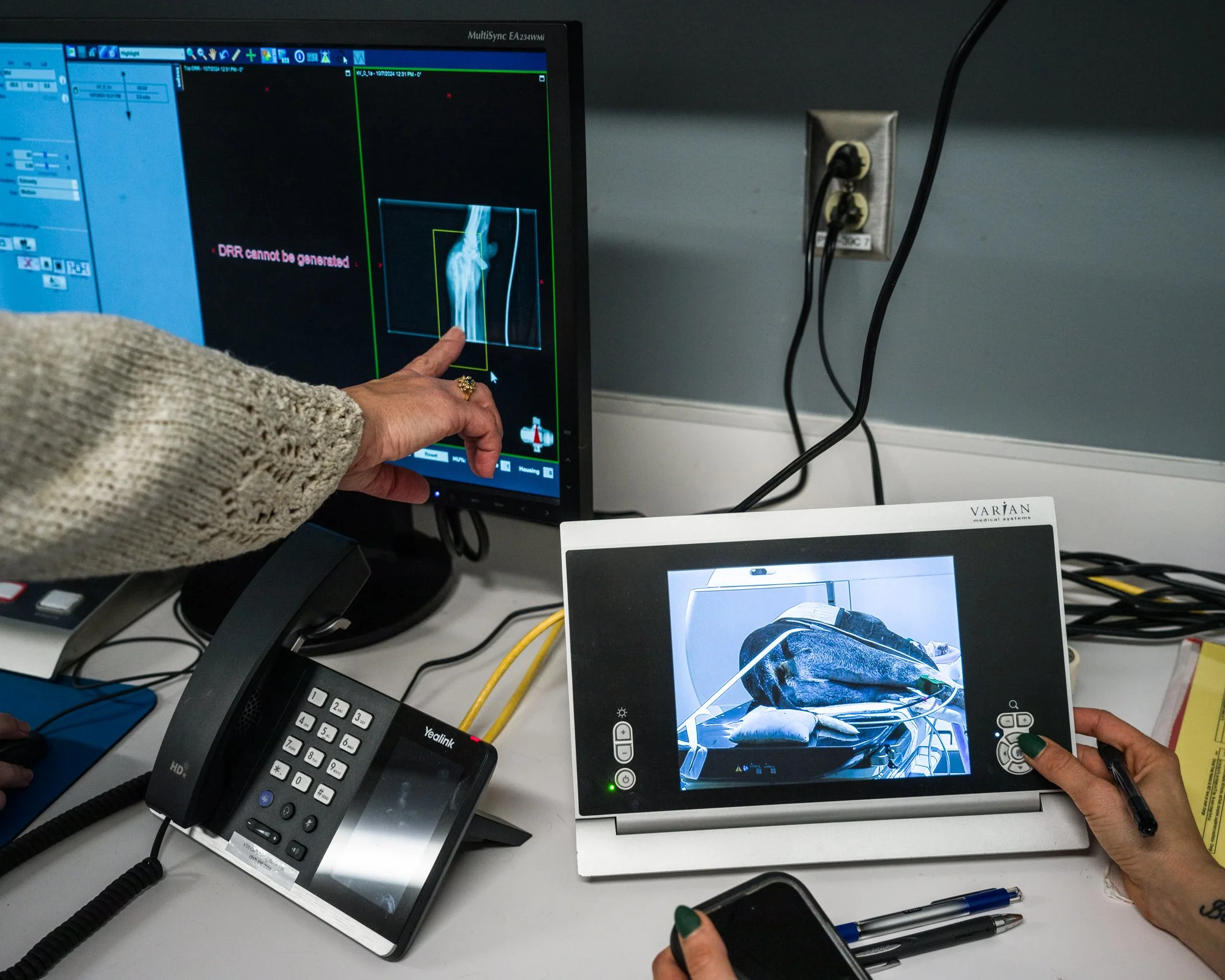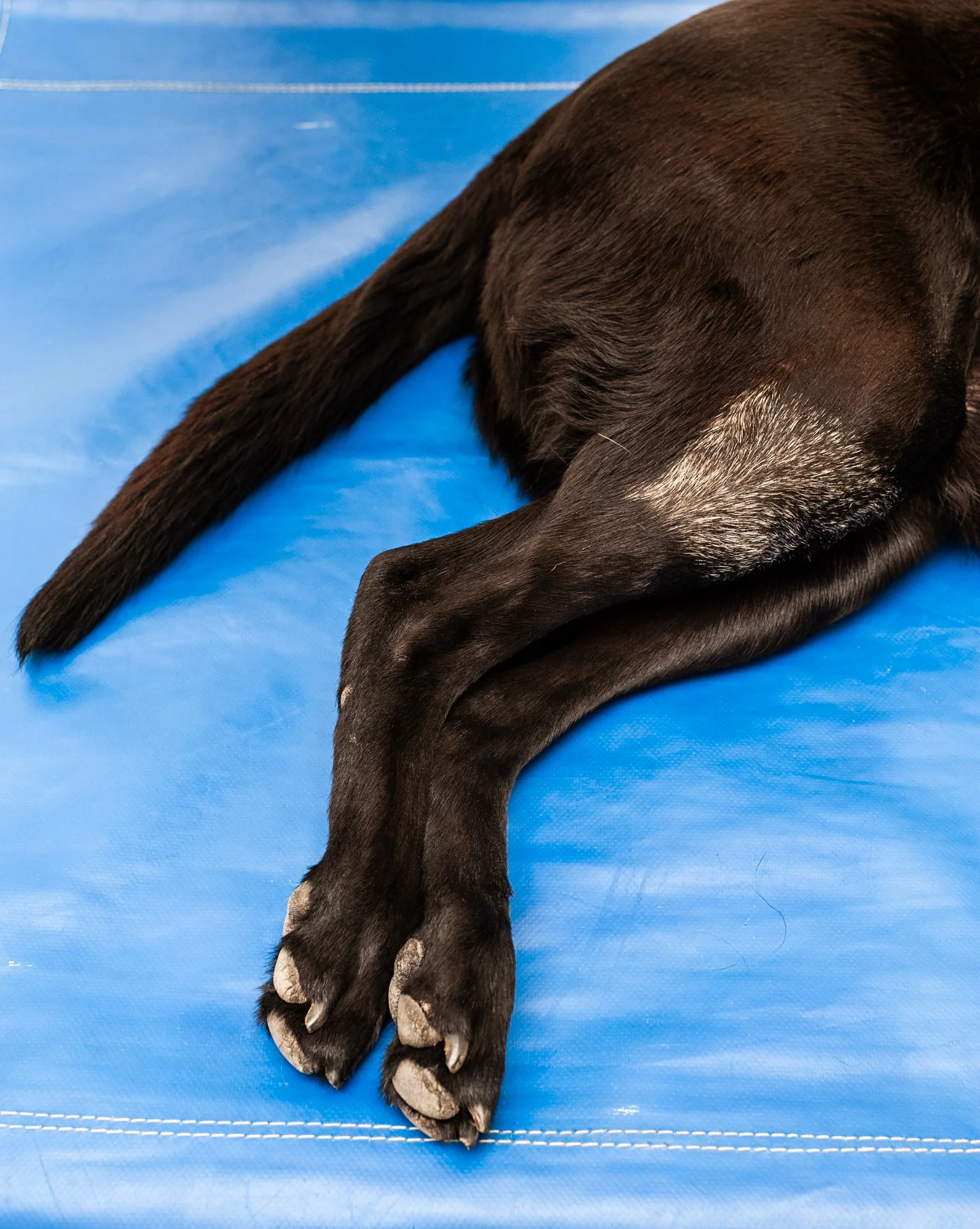
An English Mastiff at his weekly hydrotherapy session.

Cytology evaluation of a tumor showing cancer cells. Cancer cells are disorganized, and have large irregularly shaped nuclei.

A Rottweiler with bone cancer, undergoing an x-ray to see if cancer has spread to his lungs.

Waiting for the diagnosis.

Taking a bone biopsy.

Measuring tumors growing beneath the skin on an older dog.

Prepping for chemotherapy treatment.

Surgeons removing a segment of bone from the front leg of a dog with bone cancer.

A cell culture lab experiment, investigating the activation of tumor cell death with a novel cancer agent.

Preparing a dose of PAC-1, concealed in a meatball.

Frozen blood and urine samples collected from dogs undergoing new investigational therapies, which are used for future evaluation.

Leo, a 12 year old poodle-Maltese mix, has been diagnosed with urinary bladder carcinoma and is currently undergoing a bladder ultrasound.

A technician comforts a beagle receiving chemotherapy.

A German Shepherd takes a walk on a Tekscan pressure sensor-a computerized gait analysis that monitors whether her bone pain is being controlled effectively. The device measures how well a dog is able to use the affected leg following therapy.

Evaluating a leg tumor in a Great Dane to determine proper positioning for radiation delivery. The smaller screen monitors how he is during anesthesia.

A Great Dane in position for radiation therapy using the Varian TrueBeam-an advanced radiotherapy system which targets tumors with precision.

Prior to surgery, a surgical oncologist evaluates the Doberman Pinscher’s bone scan to ensure that the osteosarcoma has not spread to other parts of the skeleton.

The white region of fur, is an area previously treated with radiation therapy to improve pain control.

An owner is reunited with her black lab after his treatment.

A Pitty mix with multicentric lymphoma receives Daunomustine a novel chemotherapy agent.

Osteosarcoma of the left distal radius. An investigational therapy agent is injected into the tumor after radiation treatment. The goal is to stimulate the immune system to recognize the osteosarcoma cells both locally and throughout the body.

Collecting a blood sample - specifically peripheral blood mononuclear cells, to assess immune cell function.

An investigator soothes a lightly sleeping St. Bernard, by gently covering his eyes before a scan.

Haven, a patient with a brain tumor undergoing an MRI scan to measure the anticancer activity of a new treatment combination with 2 oral drugs that concentrate in the brain. Her tumor shrunk 50%.

Professor Fan with his adopted dog Hoover.

A professor of veterinary medical oncology and dog lover provides enrichment and companionship to research dogs included for diseases shared between pet dogs and people. Upon completion of the studies, all research dogs are adopted out to loving familles.


























An English Mastiff at his weekly hydrotherapy session.
Cytology evaluation of a tumor showing cancer cells. Cancer cells are disorganized, and have large irregularly shaped nuclei.
A Rottweiler with bone cancer, undergoing an x-ray to see if cancer has spread to his lungs.
Waiting for the diagnosis.
Taking a bone biopsy.
Measuring tumors growing beneath the skin on an older dog.
Prepping for chemotherapy treatment.
Surgeons removing a segment of bone from the front leg of a dog with bone cancer.
A cell culture lab experiment, investigating the activation of tumor cell death with a novel cancer agent.
Preparing a dose of PAC-1, concealed in a meatball.
Frozen blood and urine samples collected from dogs undergoing new investigational therapies, which are used for future evaluation.
Leo, a 12 year old poodle-Maltese mix, has been diagnosed with urinary bladder carcinoma and is currently undergoing a bladder ultrasound.
A technician comforts a beagle receiving chemotherapy.
A German Shepherd takes a walk on a Tekscan pressure sensor-a computerized gait analysis that monitors whether her bone pain is being controlled effectively. The device measures how well a dog is able to use the affected leg following therapy.
Evaluating a leg tumor in a Great Dane to determine proper positioning for radiation delivery. The smaller screen monitors how he is during anesthesia.
A Great Dane in position for radiation therapy using the Varian TrueBeam-an advanced radiotherapy system which targets tumors with precision.
Prior to surgery, a surgical oncologist evaluates the Doberman Pinscher’s bone scan to ensure that the osteosarcoma has not spread to other parts of the skeleton.
The white region of fur, is an area previously treated with radiation therapy to improve pain control.
An owner is reunited with her black lab after his treatment.
A Pitty mix with multicentric lymphoma receives Daunomustine a novel chemotherapy agent.
Osteosarcoma of the left distal radius. An investigational therapy agent is injected into the tumor after radiation treatment. The goal is to stimulate the immune system to recognize the osteosarcoma cells both locally and throughout the body.
Collecting a blood sample - specifically peripheral blood mononuclear cells, to assess immune cell function.
An investigator soothes a lightly sleeping St. Bernard, by gently covering his eyes before a scan.
Haven, a patient with a brain tumor undergoing an MRI scan to measure the anticancer activity of a new treatment combination with 2 oral drugs that concentrate in the brain. Her tumor shrunk 50%.
Professor Fan with his adopted dog Hoover.
A professor of veterinary medical oncology and dog lover provides enrichment and companionship to research dogs included for diseases shared between pet dogs and people. Upon completion of the studies, all research dogs are adopted out to loving familles.
